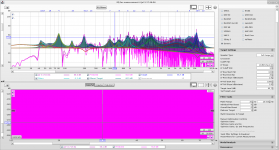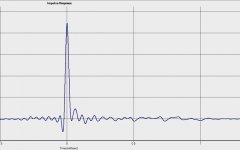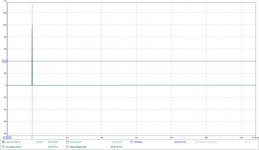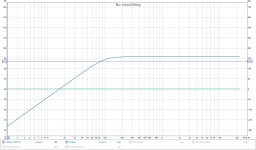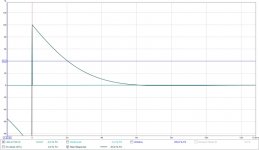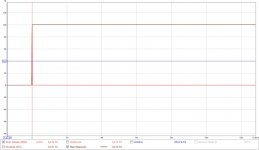my laptop crashed so i dont have rephase or rew in front of me but what I would LOVE
would be for REW to have a generic option that allows more than 20 filters ( the generic equalizer option in REW uses filters that equate to the proportional q in rephase btw)
and then an option in rephase to import these into the multiple filter banks it has automatically. i think rephase can have up to 120 filters?
thanks johnpm and pos for looking into this.
would be for REW to have a generic option that allows more than 20 filters ( the generic equalizer option in REW uses filters that equate to the proportional q in rephase btw)
and then an option in rephase to import these into the multiple filter banks it has automatically. i think rephase can have up to 120 filters?
thanks johnpm and pos for looking into this.
There seems to be an Error in REW. In case i choose "Generic" as EQ i get 17 Pk Filters, choosing rePhase i get only 1 . In both cases the Settings and Measurement are the same and i did "Reset Filters for current Measurement" before.
reGards
reGards
Attachments
Last edited:
Maybe I use the filter function in REW incorrectly, but it always gives me far more filters than I need. Going in to delete and clean up by hand is necessary. A smooth response can be found with fewer filters of lower Q.
The simplified version is what I use in rePhase
The simplified version is what I use in rePhase
You can choose how many Filters you want to get, by deactivating Filters in the Eq Section ( you will get there pressing the Button "EQ Filters") or you can set "Flatness Target" (Filter Task) to a higher Value.
This was just a Test, in reality i won´t get (set) more than 6 to 8 Filters
reGards
This was just a Test, in reality i won´t get (set) more than 6 to 8 Filters
reGards
Last edited:
A few pages back, there was discussion about linear-phase HP causing pre-ringing.
Pos, everyone... please tell me what you see in the attached impulse response.
It's from a 3-way that's linear-phase high-passed with a 48LR @ 100Hz.
I know what a text-book impulse looks like, but have no idea what we should be trying to
achieve in reality..
How much pre or post ringing do you see? Other issues?
Many thx, Mark
Pos, everyone... please tell me what you see in the attached impulse response.
It's from a 3-way that's linear-phase high-passed with a 48LR @ 100Hz.
I know what a text-book impulse looks like, but have no idea what we should be trying to
achieve in reality..
How much pre or post ringing do you see? Other issues?
Many thx, Mark
Attachments
For a linear-phase high-passed with a 48LR @ 100Hz you
can see low frequency pre-ringing with the step response.
can see low frequency pre-ringing with the step response.
I've added those ideas to the feature request list.Could it be possible to export this text file format from the Filter Tasks tab?
Or better still, copy its content to the clipboard so there would not be any need for a temporary file 🙂
Something like "send to clipboard", which could also be an interesting option for other equalizers.
Something did go wrong in the rePhase case, the filter response has become undefined. Don't want to derail this thread, so perhaps you could email me (feedback@roomeqwizard.com) the mdat file of the measurement you were using?There seems to be an Error in REW. In case i choose "Generic" as EQ i get 17 Pk Filters, choosing rePhase i get only 1 . In both cases the Settings and Measurement are the same and i did "Reset Filters for current Measurement" before.
This is all implemented now and seems to work 🙂
Hi Pos,
When you have a beta version which includes this feature, do not hesitate to ask for beta testers 😉
For a linear-phase high-passed with a 48LR @ 100Hz you
can see low frequency pre-ringing with the step response.
Thank you!
How does step response differ in what it shows from (linear) impulse response ?
On either graph, how do you know what frequency or frequencies are pre-ringing ?
Thank you!
How does step response differ in what it shows from (linear) impulse response ?
On either graph, how do you know what frequency or frequencies are pre-ringing ?
Generate a perfect LR2 in RePhase and load the impulse into REW. You'll see it has very low pre-ringing. But if you apply a LR2 to a real driver it won't be as smooth, unless that driver has first been EQ-ed to flat well beyond the crossover frequency. Putting a LR2 crossover on a real driver isn't going to make it LR2 acoustically. A driver has it's own roll off to consider and may have peaks/dips. A true LR2 crossover is getting the acoustic result follow the shape of that LR curve. Not just choosing LR2 in a program and be done with it. At least not if you want a true LR2.
The IR of a LR2 filter at 100 Hz created in RePhase:
It's FR plot:
The IR is merely a representation, most of what we see is high frequency information.
In REW you could check the Filtered IR tab to dissect the IR and set some filters there to see what it does at frequencies close to the crossover. For instance a 1/3 octave filter at 80 Hz (80Hz 1/3). If you look what happens before zero that will show you the pre-ringing (and it's level).
The STEP of a high pass LR2 at 100 Hz:
Compared to a Dirac pulse IR and STEP:
(no crossover here)
Attachments
Last edited:
"how do you know what frequency or frequencies are pre-ringing ? "
Pre-ringing is at fc and around.
Pre-ringing is at fc and around.
An externally hosted image should be here but it was not working when we last tested it.
Well, I can see it's finally time to learn REW. 😱
I've been using Smaart and have gotten where I can get pretty nice magnitude and phase traces, using rephase and miniDsp. But all I've really been doing is flattening mag and phase driver-by-driver, then putting it all together with the right timing. I haven't concerned myself with issues like ringing, or using boatloads of taps.
Do you guys have any good primer links on using all of REW's capabilities, particulary the impulse capabilities, which seem to surpass Smaart by quite a bit..?
wesayso, thank you...I do understand what you are saying about the acoustic, as opposed to electrical, goal.
I just gotta learn more about REW!
Hey, at least I could do what you told me in REW...it's a start 🙂
jmbee, thank you again...
The plot you showed of the 48LR @ 100Hz, and it's pre-ringing window between about -13.6 to -3.2ms....
I don't get how to relate the pre-ringing in that time window to the speaker impulse plot I posted in #1286.
I didn't really see any activity in the impulse plot before -0.5ms, so i cut the view off there......
....yet, from what you show me, I should expect some earlier action?
I've been using Smaart and have gotten where I can get pretty nice magnitude and phase traces, using rephase and miniDsp. But all I've really been doing is flattening mag and phase driver-by-driver, then putting it all together with the right timing. I haven't concerned myself with issues like ringing, or using boatloads of taps.
Do you guys have any good primer links on using all of REW's capabilities, particulary the impulse capabilities, which seem to surpass Smaart by quite a bit..?
wesayso, thank you...I do understand what you are saying about the acoustic, as opposed to electrical, goal.
I just gotta learn more about REW!
Hey, at least I could do what you told me in REW...it's a start 🙂
jmbee, thank you again...
The plot you showed of the 48LR @ 100Hz, and it's pre-ringing window between about -13.6 to -3.2ms....
I don't get how to relate the pre-ringing in that time window to the speaker impulse plot I posted in #1286.
I didn't really see any activity in the impulse plot before -0.5ms, so i cut the view off there......
....yet, from what you show me, I should expect some earlier action?
I found REW to have a steep, but not long, learning curve. A lot of head scratching at first. Once you get used to the way it's laid out and works, it's easy to use.
Hi,
I tried to dig a little further in order to understand the influence of the measurement position on the measurement of pre-ringing. I made two series of measurements:
- one at the listening position
- one at 50cm (20 inches) from the medium driver of my LS
Each series of measurement consisted in 3 steps:
- the impulse/step without correction
- impulse/step with the XO linearized (24 db/oct minimum phase filters at 350 and 4000 Hz) and no other correction (no other filters and no phase correction)
- impulse/step with a rePhase configuration which showed close to minimal phase at listening position
In my room, which is not optimal, the two series of measurements are significantly different as far as pre-ringing is concerned. What is close to perfect when measured at listening position is not good at 50 cm from drivers and vice versa.
This might be obvious for specialists but was an interesting discovery for me and I wanted to share it.
I tried to dig a little further in order to understand the influence of the measurement position on the measurement of pre-ringing. I made two series of measurements:
- one at the listening position
- one at 50cm (20 inches) from the medium driver of my LS
Each series of measurement consisted in 3 steps:
- the impulse/step without correction
- impulse/step with the XO linearized (24 db/oct minimum phase filters at 350 and 4000 Hz) and no other correction (no other filters and no phase correction)
- impulse/step with a rePhase configuration which showed close to minimal phase at listening position
In my room, which is not optimal, the two series of measurements are significantly different as far as pre-ringing is concerned. What is close to perfect when measured at listening position is not good at 50 cm from drivers and vice versa.
This might be obvious for specialists but was an interesting discovery for me and I wanted to share it.
Attachments
-
 No correction - listening position.jpg155.4 KB · Views: 196
No correction - listening position.jpg155.4 KB · Views: 196 -
 rePhase - XO linearized - listening position.jpg155.5 KB · Views: 206
rePhase - XO linearized - listening position.jpg155.5 KB · Views: 206 -
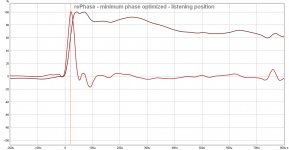 rePhase - MP optimized - listening position.jpg154.3 KB · Views: 211
rePhase - MP optimized - listening position.jpg154.3 KB · Views: 211 -
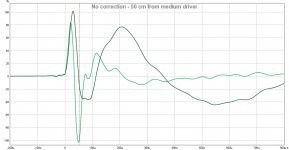 No correction - 50 cm from medium.jpg158 KB · Views: 199
No correction - 50 cm from medium.jpg158 KB · Views: 199 -
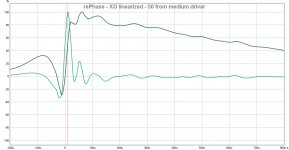 rePhase - XO linearized - 50 cm from medium.jpg154.3 KB · Views: 179
rePhase - XO linearized - 50 cm from medium.jpg154.3 KB · Views: 179 -
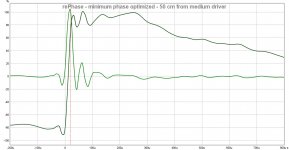 rePhase - MP optimized - 50 cm from medium.jpg158.1 KB · Views: 186
rePhase - MP optimized - 50 cm from medium.jpg158.1 KB · Views: 186
I found REW to have a steep, but not long, learning curve. A lot of head scratching at first. Once you get used to the way it's laid out and works, it's easy to use.
Thanks Pano, encouragement appreciated !
Where do i find a step by step guide to make rephase to work with a 7.1 soundcard?
I guess that some people hanging around here is comfortable with solder smoke and turning the nobs on the oscilloscope.. but software is ehh.. not our thing so to say.
Ok i need:
4 way loudspeaker check
PC check
7.1 sound card check
foobar check
rephase check
microphone check
4x stereo amplifiers check
some time...
I guess that some people hanging around here is comfortable with solder smoke and turning the nobs on the oscilloscope.. but software is ehh.. not our thing so to say.
Ok i need:
4 way loudspeaker check
PC check
7.1 sound card check
foobar check
rephase check
microphone check
4x stereo amplifiers check
some time...
- Home
- Design & Build
- Software Tools
- rePhase, a loudspeaker phase linearization, EQ and FIR filtering tool
